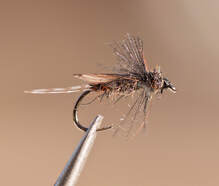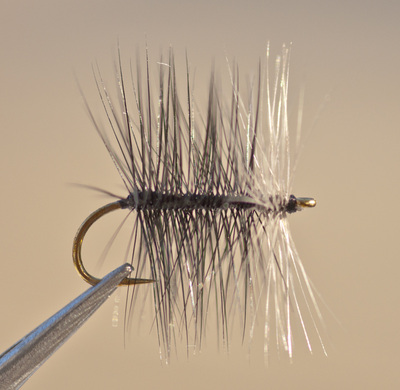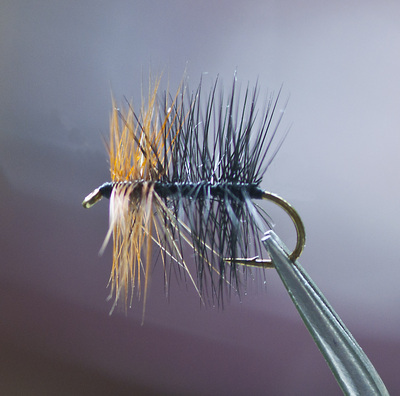Tom and I have made a game changing decision. Rather than present just a fly of the month, we thought a deeper series of layman’s entomology paired with fly tying may be more useful to both angler and anglers that are fly tyers. Our first article for 2015 is in two parts, Winter Stoneflies. Part One will cover the adult stage and Part Two will cover the nymph stage. We will have either two part articles or three part articles where more entomology pairing is in order. We hope you have enjoyed the Fly of the Month articles and you will appreciate the upcoming articles even more. Our intent is for you be become a better angler as well as a better tyer.
Winter Stonefly – Part One - Adults
During the cold, winter months of December thru March in the Southern Appalachians, winter stoneflies flourish when there are few other aquatic or terrestrial insects around. Depending on local nomenclature, these insects may be called Early Winter Stones, Small Winter Blacks, Willowflies, Snow Bugs or Snow Fleas. Winter stoneflies hatch systematically during the winter months much like most other aquatic insects hatch during the spring, summer or fall. These are insects with antifreeze in their system that allows them to be mobile during even the cold days. The Blue Winged Olive (BWO) mayfly will hatch during the winter months only during a warm, cloudy day.
There are actually two groups of winter stoneflies, Capniidae, which are considered the Small Winter Stoneflies and Taeniopterygidae, which are considered the Early Brown Stoneflies. The Early Browns may sometimes appear in the snow yet by their brown color and larger size, they are not mistaken as Snow Bugs or Snow Fleas and their hatching timeframe is late-winter often when the snow may no longer be around in the Southern Appalachians. The Early Winter Stones may be size 14-22, typically the adult is size 20 and the Early Brown Stones may be size 14-18, typically the adult is size 16.
Most anglers notice winter stoneflies walking on the snow searching for a mate as their small black or brown bodies are in sharp contrast to the white canopy on the ground. However, prior to being found on land, the winter stonefly escapes from its nymphal shuck at the surface and flutters across the glassy surface film in a bee-line to the stream bank, a highly vulnerable route. If the wings are dry enough prior to reaching the stream bank, the winter stonefly will begin to fly and may fully escape the risk of becoming food for a trout. Trout follow the fluttering winter stonefly and often will jump out of the water to catch a winter stonefly that takes to flight sooner than expected.
The fluttering wings of the Small Winter Blacks give the fly the appearance of a gray ball from the angler’s view and a small, dark body with lots of motion from the trout’s view. The fluttering wings of the Early Browns give the appearance of a brown ball from the angler’s view and a dark body with lots of motion from the trout’s view. The fluttering stonefly is best imitated with a bivisible fly pattern presented with a jerky motion across the surface.
At times the stonefly may stop on the glassy surface momentarily and give the appearance of a very still, flat-winged adult stonefly. During this time, the no drag presentation and the fly must very closely imitate the actual stonefly to be effective, being a near-realistic fly pattern.
Out experience with a winter stonefly hatch was on the Davidson River in early-December 2013. Tom and I witnessed a systematic hatch of Small Winter Black Stoneflies for several hours. The trout turned on to the hatch and literally stopped taking droppered nymphs or streamers. We would have paid $10 a fly for a Gray/Black Bivisible. We managed to catch fish on a size 20 Black Elk Hair Caddis on occasion. This was not an ideal fly but it caught a few trout. We imagine still how many trout we would have taken and released in several hours with the fly patterns present below.
Small Winter Black Stonefly
Gray/Black Bivisible - see Brown Bivisible (under Attractor flies) for tying instructions
Early Brown Stonefly - same Small Winter Black Stonefly with color variation
Brown Bivisible - see Attractor flies for photo and recipe
- Tom Adams, Alen Baker
Small Winter Black Stonefly Recipe
Hook: Tiemco 906 BL or equivalent – size 14,16,18,20,22
Thread: Black Uni 8/0 or equivalent
Tail: Bronze Mallard or equivalent
Abdomen: Wapsi Brown Natural Hares Ear
Thorax: Waspi Brown Natural Hares Ear
Wing: Grizzly Hen or Rooster Hackle
Legs: CDC, black
Head: Wapsi Brown Natural Hares Ear
Note : The Early Brown Stonefly uses Natural CDC for the wing and brown hares ear, otherwise follow the same instructions
Instructions:
1. Secure hook in vise and begin touching thread wraps from the two-thirds mark back to above where the hook barb would be. Let the bobbin hang.
2. Select two bronze mallard barbules and tie in to form the tail. The length should be about half the hook shank. Tie them on to each side of the hook with the natural curve up and away from the shank. Advance the thread to the halfway mark, trim away the waste and return the thread to the tie in point of the mallard in tight touching turns. Let the bobbin hang.
3. Select a very small portion of dubbing and start forming a dubbing rope, twisting the dub on by spinning between your thumb and index finger, in one direction until a very delicate and thin rope is formed. It is preferable to make several dub ropes to one that is too large to be effective. The abdomen on a stonefly is very skinny. When you wrap the dub on the hook, make the turns slightly overlapping, but not doubled and continue wrapping up to the two-thirds mark. Let the bobbin hang.
4. Select a hen or rooster feather that is fairly large, for a size 18 fly like this, the grizzly should be for a size 10 or 8 hook. You will need long barbules to form the wing. Once selected, stroke the feathers back from the tip, capturing them with your index and thumb. The length of the barbs trapped needs to be sufficient to cover the abdomen only. Tie the hackle in, on top of the hook shank while you continue to trap the length of barbs. Once secure you can trim the front of the hackle and the rear as well. This will form a low wing that is slightly cupped over the abdomen. Let the bobbin hang.
5. Select a black CDC feather and stoke the barbs forward, tying in directly in front of the wing. Secure with several wraps of thread and let the bobbin hang. Wrap the CDC as you would rooster hackle in touching turns. Two or three is sufficient. Tie in the tip and trim away the waste. Advance the thread to the eye and let the bobbin hang.
6. Dub the thread again, but only with enough for a small head. Begin the dub at the eye and advance to the CDC tie in and back again to the eye. Whip finish, cut away the thread.
7. The CDC will trim to form legs, leave the top slightly longer.
Note : Omitted is an option to tie in front antennae, if you choose to do so use Moose body hairs and tie in before forming the head. The same is true for the rear ones.









